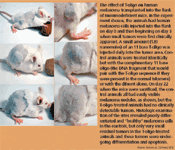- Case-Based Roundtable
- General Dermatology
- Eczema
- Chronic Hand Eczema
- Alopecia
- Aesthetics
- Vitiligo
- COVID-19
- Actinic Keratosis
- Precision Medicine and Biologics
- Rare Disease
- Wound Care
- Rosacea
- Psoriasis
- Psoriatic Arthritis
- Atopic Dermatitis
- Melasma
- NP and PA
- Skin Cancer
- Hidradenitis Suppurativa
- Drug Watch
- Pigmentary Disorders
- Acne
- Pediatric Dermatology
- Practice Management
- Prurigo Nodularis
- Buy-and-Bill
Article
Telomere signaling shows promise against melanoma
Vienna — Long the focus of intense investigation, telomeres may play akey part in inducing DNA damage responses that could provide a weapon against melanoma.

"Telomeres play a very important role, and have almost certainly since the development of eukaryotic life on Earth, in protecting cells and instructing cells to kill themselves if they're damaged, in essence, preventing the organism from developing cancers or otherwise having its genome damaged. The integrity of the genome is critical to life, especially in higher organisms," says Barbara A. Gilchrest, M.D., chairman, department of dermatology, Boston University School of Medicine.
Cell suicide One way in which telomeres protect against genetic damage is by inducing cell suicide in response to extensive and presumably irreparable DNA damage (Evan G, Littlewood, T. Science. 1998 Aug 28;281(5381):1317-322.).
"Details of this are still being worked out in the literature," she says, "but when the telomeres get critically short, the cell somehow knows that it's gone through enough replications, and it will never replicate again no matter how much stimulation one gives it."

"It's also been shown by various laboratories that in some other way, telomeres also are involved in DNA damage signaling," Dr. Gilchrest says. "In particular, researchers at Rockefeller University have shown that the telomere - the last several thousand base pairs at the end of each chromosome - is not actually straight, but loops back on itself. One strand of the double-stranded DNA in the chromosome extends beyond the other, and thatsingle-stranded overhang is used to seal the loop. It tucks back into the proximal duplex double-stranded portion of the telomere and is held in place by various proteins."
Under normal circumstances, "the cell doesn't see the very end of this telomere," Dr. Gilchrest says. "But if one disrupts that structure so the very end of the telomere (a single-stranded TTAGGG overhang) is exposed, then the cell produces DNA damage responses. Depending on the cell type, as a result of all this damage signaling, cells will either undergo apoptosis or enter senescence (Karlseder J. et al. Science 1999 volume 283; 1321-1325; Van Steensel B. et al. 1998 Cell 92, 401-413; Karlseder J. et al. 2002 Science 295, 2446-2449.)."

What happens This knowledge suggested to Dr. Gilchrest and her colleagues that exposure of the telomere overhang sequence constitutes the physiological signal for senescence or apoptosis.





